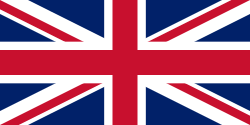 | |
| Use | Naval ensign |
|---|---|
| Proportion | 1:2 |
| Adopted | 1968 as jack; 2013 as ensign |
| Design | White field, in the canton the National Flag of Canada, in the fly an eagle superimposed on an anchor beneath a naval crown, all blue |
 | |
| Use | Naval jack |
| Proportion | 1:2 |
| Adopted | 1965 as jack and ensign; 1968 as ensign; 2013 re-adopted as jack |
| Design | The national flag of Canada: A vertical triband of red (hoist-side and fly-side) and white (double width) with the red maple leaf centred on the white band. |
The Canadian Naval Ensign (French: pavillon naval canadien [1] ) is the flag worn at the stern or (optionally when at sea) at the gaff of His Majesty's Canadian Ships. The ensign is also the flag of the Royal Canadian Navy (RCN) and is used on land in this capacity.
Contents
The ensign consists of a white flag with the National Flag of Canada in the canton, and in the fly a navy blue emblem comprising an anchor, an eagle and a naval crown. The ensign's emblem is similar to the central device of the former RCN badge (which was redesigned in 2016), but replacing Saint Edward's Crown with a naval crown.








